Recreation centers keep popping up all over the country. These centers are typically large and expensive to build. Creative financing is often required to get these projects off the ground and to provide the programming that stakeholders want and need.
Take, for example, the 135,000-sf Foglia Foundation Health and Recreation Center at Harper College in Palatine, Ill., which reopened last September after a $41 million renovation of that 40-year-old building, led by designer CannonDesign and construction manager Mortenson.
The community college collaborated on this project with Northwest Community Healthcare, which agreed to pay for the fitout of a new clinic that originally was going to be 5,000 sf but expanded to 10,000 sf, says Steve Paterson, Harper College’s campus architect. The college leases this space, known as the NCH Outpatient Care Center, to the hospital, and its services are available to students, employees, and the community.
The Building Team added 10,000 sf to the rec center to make way for new fitness and exercise rooms, six classrooms, and team training and competition areas, including a new dedicated wrestling room and sports medicine facilities with a hydrotherapy bath. The rec center is also headquarters for the Harper Golden Hawks athletic department and teams.
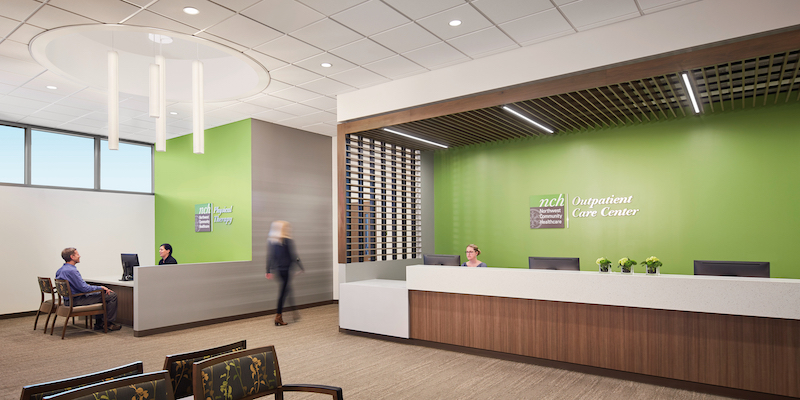
Northwest Community Healthcare agreed to finance the fitout and enlargement of a leased clinic (above) within the Foglia Foundation Health and Rec Center. And the Palatine Parks District contributed to keep the facility's pool open (below), which the district operates. Image: Dave Burk, courtesy of CannonDesign
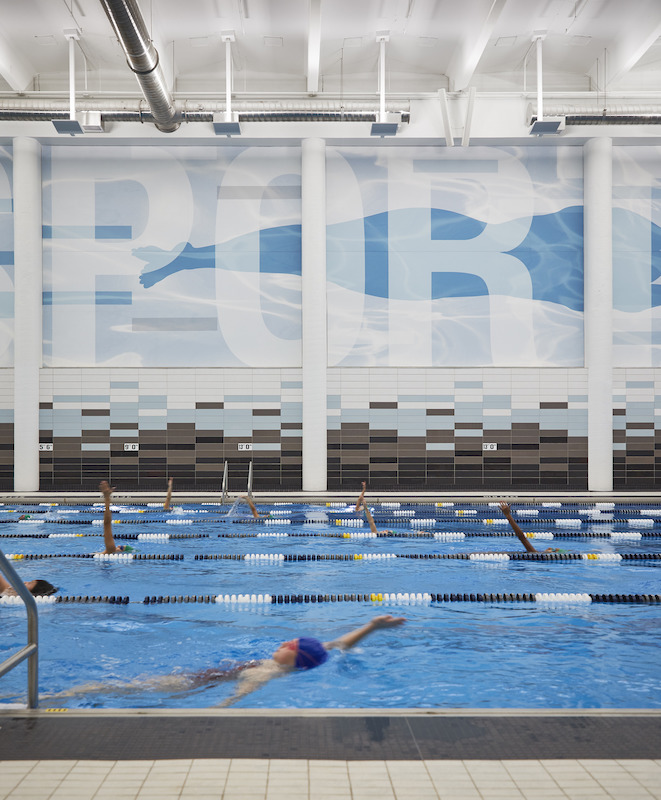
Palatine (Ill.) Park District kicked in $9 million toward the renovation to keep the facility’s pool open. The District operates the pool, says Paterson. whose programming includes aquatic, dance, sports, and fitness activities. “With one facility, we hit the trifecta,” says Mike Clark, the District’s executive director.
“I don’t know if we’ve ever done a project quite like this before,” says Roland Lemke, AIA, LEED AP, Design Principal for CannonDesign, about the way the renovation was funded. He observes that the rec center is mostly used by students during the day and by the community during nighttime hours.
CannonDesign was also involved in the new 120,000-sf Laurier YMCA Athletics and Recreation Centre in Brantford, Ont., which opened on September 14, 2018. The financing for this project came from the Y, the provincial and federal governments, corporate contributions, and Wilfrid Laurier University, whose campus is right next to the Y’s site.
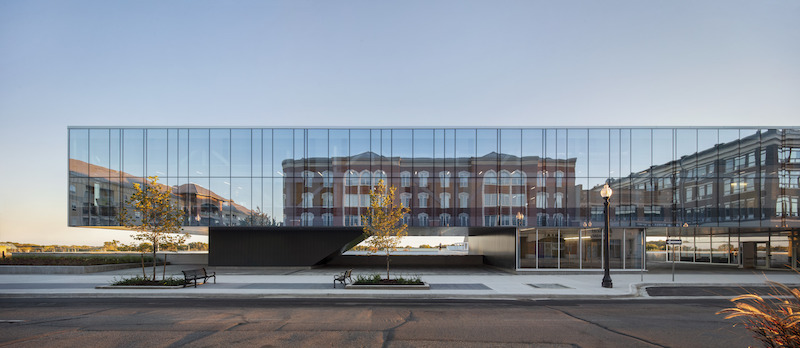
The Laurier Brantford (Ont.) YMCA and Recreational Center, whose nearly 68 million Canadian dollars in funding came from government, academic, and private sources. Image: Adrien Williams, courtesy of CannonDesign
This project had been in the works for at least eight years. Prior to the opening of the new building, the Y had been operating out of a small, temporary space, and the university had “a very small gym” for a student body that had grown to 2,500, say Antonio Araujo and Ulrike Gross, respectively the university’s Active VP-finance and administration and Acting VP-facilities and asset management.
The plans shifted into higher gear two years ago, thanks to 500,000 Canadian dollars in government grant money that paid for the building’s initial design, from which emerged “a rough concept,” says Araujo.
The project appealed to the city of Brantford as a way to help revitalize its downtown, says Genevieve Hladysh, senior regional manager for the Brantford-Hamilton-Burlington YMCA and Recreational Center. The new Y sits on a three-block site on the south side of the city, which tore down 39 mostly vacant retail buildings to clear space for construction. (Araujo and Gross note that the university initially wasn’t all that interested in this site whose main block was entirely below grade.)
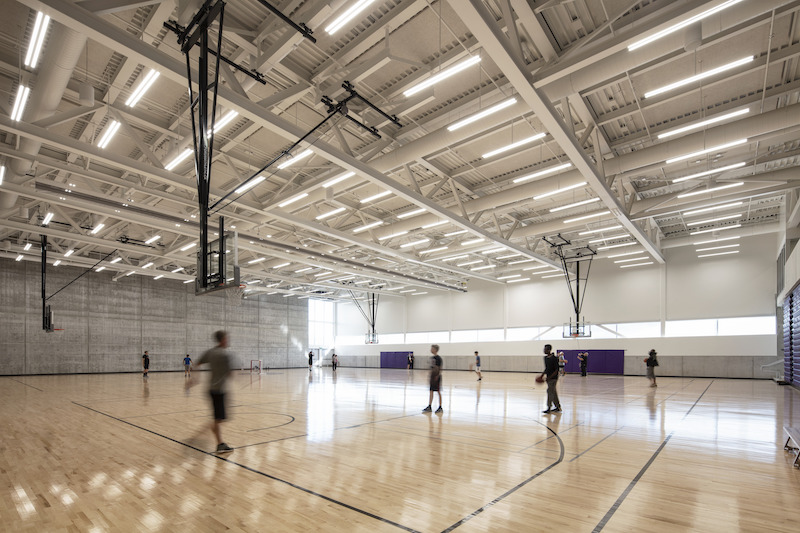
The Brantford YMCA includes a double gym. Image: Adrien Williams, courtesy of CannonDesign
The original budget for the new YMCA was 58.4 million Canadian dollars. But as more funding came on board, the budget rose to 67.7 million Canadian dollars. The federal and provincial governments each contributed C$16.7 million. The city provided $5.2 million, and another C$5.7 million was raised from a community capital campaign. The rest came from the YMCA and Laurier.
The building serves Brantford residents and university students with amenities that include an aquatics center, a double gym with retractable seating for 860 people, health consultation rooms, three studios, student lounge, and a 3,498-sf strength area.
This is the first Y to come together in an integrated space, and while the programming for each stakeholder group is spelled out contractually, “we tried to design the spaces to be as multifunctional as possible,” says Hladysh. Colleen McKenna, LEED AP, firmwide leader for CannonDesign’s sports, rec, and wellness practice, adds that while the university had a “big voice” in the programming, “there was balance and negotiation in the program distribution.”
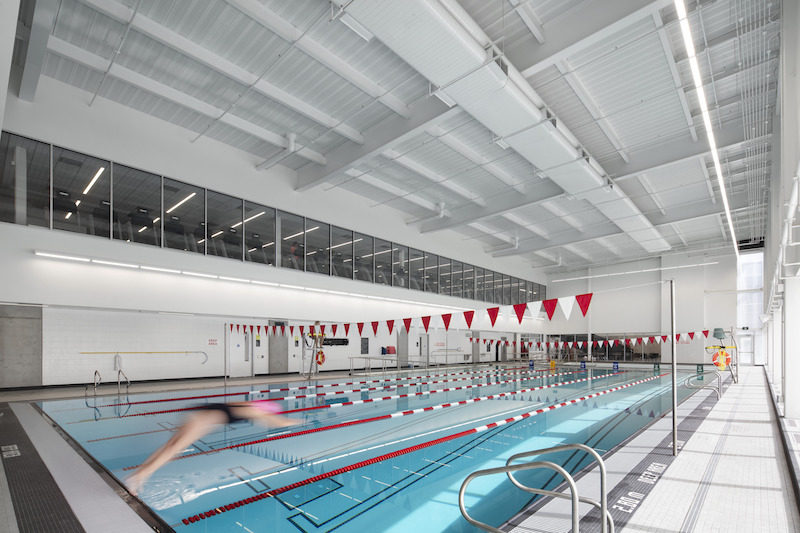
The Y's membership now exceeds 5,300, and its aquatics center is open to students and the community alike. Image: Adrien Williams, courtesy of CannonDesign
Part of the new Y’s increased cost was attributable to the construction unearthing a large archeological find: nearly 440,000 indigenous artifacts that included coins, clothing, and pottery, some of which might date back to 500 BCE. Hladysh says that the YMCA enlisted Six Nations partners to monitor the excavation. She adds that some kind of exhibit space within the new Y is under consideration.
Related Stories
| Jun 12, 2014
Austrian university develops 'inflatable' concrete dome method
Constructing a concrete dome is a costly process, but this may change soon. A team from the Vienna University of Technology has developed a method that allows concrete domes to form with the use of air and steel cables instead of expensive, timber supporting structures.
| Jun 11, 2014
Esri’s interactive guide to 2014 World Cup Stadiums
California-based Esri, a supplier of GIS software, created a nifty interactive map that gives viewers a satellite perspective of Brazil’s many new stadiums.
| Jun 4, 2014
Construction team named for Atlanta Braves ballpark
A joint venture between Barton Malow, Brasfield & Gorrie, Mortenson Construction, and New South Construction will build the Atlanta Braves ballpark, which is scheduled to open in early 2017. Check out the latest renderings of the plan.
| Jun 2, 2014
Parking structures group launches LEED-type program for parking garages
The Green Parking Council, an affiliate of the International Parking Institute, has launched the Green Garage Certification program, the parking industry equivalent of LEED certification.
| May 29, 2014
7 cost-effective ways to make U.S. infrastructure more resilient
Moving critical elements to higher ground and designing for longer lifespans are just some of the ways cities and governments can make infrastructure more resilient to natural disasters and climate change, writes Richard Cavallaro, President of Skanska USA Civil.
| May 22, 2014
Just two years after opening, $60 million high school stadium will close for repairs
The 18,000-seat Eagle Stadium in Allen, Texas, opened in 2012 to much fanfare. But cracks recently began to appear throughout the structure, causing to the school district to close the facility.
| May 20, 2014
Kinetic Architecture: New book explores innovations in active façades
The book, co-authored by Arup's Russell Fortmeyer, illustrates the various ways architects, consultants, and engineers approach energy and comfort by manipulating air, water, and light through the layers of passive and active building envelope systems.
| May 19, 2014
What can architects learn from nature’s 3.8 billion years of experience?
In a new report, HOK and Biomimicry 3.8 partnered to study how lessons from the temperate broadleaf forest biome, which houses many of the world’s largest population centers, can inform the design of the built environment.
| May 16, 2014
Toyo Ito leads petition to scrap Zaha Hadid's 2020 Olympic Stadium project
Ito and other Japanese architects cite excessive costs, massive size, and the project's potentially negative impact on surrounding public spaces as reasons for nixing Hadid's plan.
| May 13, 2014
First look: Nadel's $1.5 billion Dalian, China, Sports Center
In addition to five major sports venues, the Dalian Sports Center includes a 30-story, 440-room, 5-star Kempinski full-service hotel and conference center and a 40,500-square-meter athletes’ training facility and office building.

















